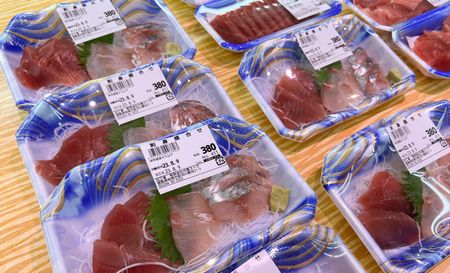By Yuka Obayashi and Katya Golubkova
TOKYO (Reuters) – Japan is ramping up promotional efforts to boost seafood exports to more destinations in Asia, the U.S., and Europe as it seeks to fill a sales gap left by a year-long Chinese import ban, the head of the Japan External Trade Organization said.
China, previously the biggest market for Japanese seafood exports, banned purchases of Japanese-origin seafood citing risk of radioactive contamination after Tokyo Electric Power started releasing treated water from the wrecked Fukushima nuclear power plant into the Pacific Ocean last August.
Japan’s exports of agricultural, forestry and fishery products in the first half of 2024 fell for the first time since 2020 as exports to China plunged 43.8%. Scallops were the hardest-hit, dropping 37% year-on-year.
“We haven’t yet fully compensated for the loss from China in volume, but exports to the U.S., Canada, Thailand and Vietnam are increasing, significantly boosting momentum in alternative markets,” said Norihiko Ishiguro, the chairman of the Japan External Trade Organization, or JETRO.
The government-backed trade body is promoting the diversification of export destinations for scallops and other products impacted by China’s curb by establishing new commercial channels in Asia, the U.S., and Europe, he added.
“Our intensive promotional efforts have enabled us to redirect 20-30% of the scallop exports lost due to China’s import ban,” Ishiguro said on Friday, ahead of the first anniversary of the Fukushima water release on Aug. 24.
“There is significant growth potential for Japanese seafood exports … it won’t take long to make up for the gap caused by China’s ban,” he added.
Japan exported 87.1 billion yen ($592 million) worth of aquatic products to China in 2022, making it the biggest market for Japanese exports, according to government data. The figure, which includes pearl and coral, plunged to 61 billion yen in 2023 and 3.5 billion yen in the first half of 2024.
PROMOTION EFFORTS
With an additional 5 billion yen budget from the government, the JETRO has supported 170 events in the past year to promote scallops, yellowtail and other fishes in more than 70 cities in Japan and abroad, including Davos, Switzerland and San Francisco, according to Ishiguro and another JETRO official.
It has also invited renowned chefs, influencers and buyers from abroad to tour fish markets and fisheries in Japan, while campaigns in Thailand promoted Japanese seafood in non-Japanese restaurants like Thai, Italian, Chinese.
Mission have also been sent to Vietnam and Mexico to explore alternative processing sites for scallops, aiming to replace China’s supply chain, Ishiguro added.
Growth can be expected in emerging markets like Eastern Europe and the Middle East, he noted, pointing out that there are 2,000 Japanese restaurants in Poland alone.
The weak yen and the boom in Japan tourism are also contributing factors, he said, adding there is no longer any reputational risk linked with Japanese seafood outside of China.
($1 = 147.1500 yen)
(Reporting by Yuka Obayashi and Katya Golubkova; Editing by Himani Sarkar)





